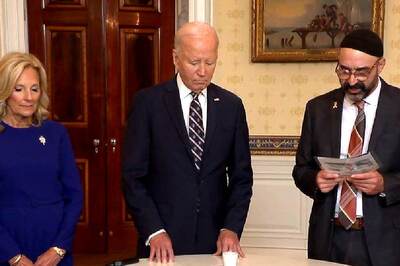
views
Having won a series of local elections in Gujarat, Maharashtra and now Chandigarh, the Arvind Kejriwal-led Aam Aadmi Party (AAP) is feeling sufficiently confident of making a splash across the country.
The party has drawn up ambitious plans of entering the electoral fray in Punjab, Goa, Uttarakhand and Uttar Pradesh in preparation for the big 2024 Lok Sabha battle. Not just that but the AAP also believes it is ready to take on the Shiv Sena in the Mumbai municipal election.
Undoubtedly, the AAP is far better prepared for these Assembly polls than it was for the 2014 Lok Sabha polls which proved to be a disaster for the party, but there is no taking away from the fact that it faces a challenging task ahead as it could end up losing focus by spreading itself too thin. Moreover, as a party which has a larger presence and following among the urban voters, it will be using its energies and resources in elections where it has little or no chance of scoring.
It is a tough call for Arvind Kejriwal. Should he focus on the upcoming municipal elections in Delhi and Mumbai or should he jump on to the electoral bandwagon in the upcoming Assembly polls. The AAP cannot afford to be complacent about the Delhi municipal election for it has not been able to dislodge the BJP which controls the city corporations even after winning big in Assembly polls. In Mumbai, the cash-rich municipal corporation (BMC) is known to be Shiv Sena’s turf. Kejriwal will have to muster more than a large share of resources and manpower to make a dent here.
Instead Kejriwal has chosen to try his luck in the larger playing field. In the process, he has tied the AAP’s future prospects to its performance in these four states which will determine if it has the necessary ground support and the organizational strength to take on the well-entrenched Bharatiya Janata Party (BJP) and regional parties to replace the Congress. On the flip side, an adverse verdict will derail the party’s plans of going national.
All Eyes on Punjab
Before embarking on its expansionist plans, the AAP will remember how it came a cropper when it recklessly contested over 400 seats in the 2014 Lok Sabha polls in the mistaken belief that it enjoyed widespread support after its impressive debut in the 2013 Delhi elections. After this comedown, Kejriwal changed tactics and decided that instead of going for the big kill, he would concentrate on Delhi, smaller states like Goa and Uttarakhand and various local elections in order to test the waters.
The AAP has come a long way since 2014, having registered two emphatic victories in Delhi and followed it up by forays in Gujarat where it won 42 seats in the local body elections and Maharashtra where it registered a score of 96 in gram panchayat polls in January this year.
The AAP’s big win in the Chandigarh municipal election on Monday where it bagged 14 of the 35 seats is particularly encouraging for Kejriwal as it comes a few months before the Punjab Assembly election. Given this poll result and the AAP’s past performance in Punjab when it won four Lok Sabha seats in 2014 and emerged as the main opposition party with 20 seats in the last Assembly polls, it would be logical for Kejriwal to concentrate on this state.
Of the four poll-bound states where the AAP is planning to try its luck, it is best placed in Punjab since it enjoys a degree of support here, especially in the urban areas. However, Punjab is no longer a bipolar state. Instead, it has recently witnessed a proliferation of political parties, including former chief minister Amarinder Singh’s new outfit, Sukhdev Singh Dhindsa-led Akali Dal (Sanyukta) and the political front proposed by farmers’ unions, which will be battling it out for 117 Assembly seats along with the Congress, the Shiromani Akali Dal and the BJP.
This certainly does not augur well for the AAP as it will lead to a splintering of votes, throwing up a possibility of a hung house. The AAP could still be a lead player here but, at this juncture, it is not clear if it will cross the majority mark. As a result, the AAP will have to put its best put forward in Punjab so as to retain the momentum it has gained with its Chandigarh win in view of the complex electoral scene in the state. In any case, a win in a municipal election does not guarantee a victory in Assembly polls. The Congress had won only four seats in the last Chandigarh municipal election but went on to win big in the 2017 Punjab Assembly election.
Is AAP Spreading Itself Too Thin?
At a time when it should be focusing on Punjab, which happens to be the AAP’s strongest suit, the party leadership has decided it is time to move out of the confines of Delhi and Punjab. This obviously comes with its own set of challenges even though it is making a valiant effort by hard selling its Delhi model of development.
Goa is the other state where the party has some presence even though it failed to win a single seat in the last election and polled a meagre 6.3 per cent vote. With Mamata Banerjee-led Trinamool Congress also throwing its hat in the ring, challenging established players like the Congress and the BJP, Goa is also set for a multi-corner contest, making it difficult for the AAP though it has managed to rope in senior leaders like Dayanand Narvekar. Similarly, the AAP faces an uphill task in Uttarakhand where the Congress currently appears to have an upper hand over its political opponents. The AAP can, at best, play spoiler here.
While Kejriwal’s move to contest elections in Goa and Uttarakhand is still understandable, it is difficult to fathom his reasons for entering the electoral fray in Uttar Pradesh where caste and religion are key to an election outcome. The Hindi heartland state has fiercely competitive and established players in the field already. The ruling BJP is pulling out all stops to retain power here with a heady mix of Hindutva, social engineering and a plethora of freebies. The Samajwadi Party, having the assured support of Yadavs and Muslims, is putting up a tough fight, with its leader Akhilesh Yadav’s rallies drawing huge crowds. Mayawati’s Bahujan Samaj Party may not be ahead in the race this time but it does have the support of the Jatav caste to which she belongs while the Congress is making a valiant attempt to stay afloat with party general secretary Priyanka Gandhi Vadra’s outreach to women voters.
With two months to go before the Assembly polls, the ground situation could still change. For the present, however, the jury is still out whether Arvind Kejriwal will succeed in his endeavours this time. Or will he be remembered as a young man in a hurry.
The author is a senior journalist. The views expressed in this article are those of the author and do not represent the stand of this publication.
Read all the Latest Opinions here


















Comments
0 comment